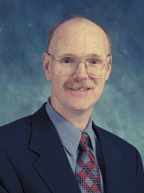 |
Michael Sitorius, M.D. |
That was the message delivered to the University of Nebraska Board of Regents by Michael Sitorius, M.D., professor and chairman of the UNMC department of family medicine, at Saturday’s meeting in Nebraska City.
“We truly have a 500-mile wide campus,” Dr. Sitorius said. “We’re very proud of our rural health program. It is one of the leading programs in the country and has been recognized for its quality.” In the most recent rankings of graduate schools by U.S. News & World Report, UNMC’s rural health medicine program was ranked No. 10 out of approximately 125 medical schools.
Dr. Sitorius cited the Rural Health Opportunities Program (RHOP) as one example of how UNMC is meeting the needs of rural Nebraska. RHOP is a partnership with Chadron State College and Wayne State College. The program allows for CSC and WSC students to be accepted into medical and dental school at UNMC at the beginning of their first year of undergraduate studies, assuming the students meet certain requirements.
Since the program began in 1992, a total of 423 students from 193 communities have enrolled in the RHOP program. Of this total, 237 have graduated, while 186 are still in school. Of the RHOP graduates, 56.5 percent of them are practicing in rural communities in Nebraska and another 14.5 percent are practicing in rural communities in bordering states.
“We feel RHOP has been an unqualified success,” Dr. Sitorius said. “Rural communities are struggling to recruit and retain health professionals. Some small towns have no health professionals, and people in these towns have to drive significant distances for their health care.
“With RHOP, we try to identify those students who would be most likely to practice in a rural setting once they complete their educational training. It has been a tremendous tool in helping us fill the void of health professionals in rural communities.”
By getting health professionals to return to rural communities, Dr. Sitorius said the program has had a huge economic impact. “It’s estimated that each dentist that goes to a rural community generates $1.3 million a year for the local economy,” he said. “For each physician in a rural community, the economic impact is $1 million per year.”
Each year, UNMC offers educational programs in agro-medicine and cultural competency to students at nine undergraduate institutions in Nebraska. To date, 163 students from 113 Nebraska communities have taken the courses at UNMC. Of the students who have gone on to graduate, 50 percent enrolled in academic programs at UNMC after completing their undergraduate education.
Some of the other highlights of UNMC’s rural health initiatives cited by Dr. Sitorius included:
- UNMC has awarded more than $130,000 to 62 communities. These grants promote collaboration between school districts and local health care providers to promote student interest in the health care professions. .
- Each year, UNMC students do 1,200 rural rotations in more than 90 Nebraska communities.
- Resident physicians who get their resident training through UNMC’s Family Medicine Rural Training Track are likely to practice in rural Nebraska once they complete their training. Of the 49 graduates from the program, 70 percent are practicing in rural Nebraska communities, while 22 percent are practicing at rural sites in bordering states.
- Since 2001, UNMC has been awarded $3.2 million from the Health Resources and Services Administration (HRSA), which is part of the U.S. Department of Health and Human Services. The money has been used to establish Area Health Education Centers (AHEC) in Grand Island and Norfolk, and in September, a new AHEC will be opened in Scottsbluff. Of the total funding, 75 percent goes to rural communities for programs and staffing. By the end of 2004, 16 employees will be working at the three AHEC sites.
- The Central Nebraska AHEC in Grand Island was one of only 10 sites in the country to receive the prestigious Hablamos Juntos (translated as “we speak together”) planning grant from the Robert Wood Johnson Foundation. The grant has provided funding for several Latino-related projects, including interpreter training programs, a Spanish-language car safety seat technician training and programs for Latino diabetes care and smoking cessation.